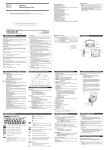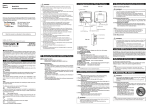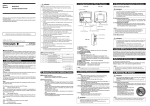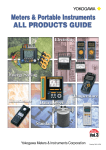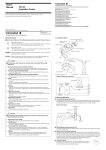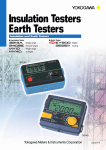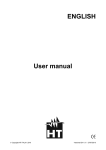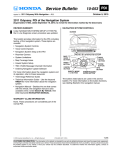Download Manual - Test Equipment Depot
Transcript
User’s Manual Model MY40 Insulation Resistance Tester Thank you for purchasing the Yokogawa M&C MY40 Insulation Tester. To optimize all the functions of the instrument, please read this manual thoroughly before operating it. Store this manual in a safe place for future reference. 1st Edition : Nov. 2000(YG) All Rights Reserved, Copyright ©2000, Yokogawa M&C Corporation IM MY40-E 2nd Edition: July, 2001 1. Safety Precautions WARNING Always observe the following instructions. Failure to do so may result in electrical shock or other dangers that may lead to serious injury or the loss of life. Yokogawa M&C Corporation is in no way liable for any damage resulting from the user's mishandling of the tester. For safe use of this tester, the following safety symbols are used in the user's manual: WARNING This indicates that the operator must refer to an explanation in the user's manual in order to avoid the risk of serious injury or the loss of life. CAUTION This indicates that the operator must refer to an explanation in the user's manual in order to avoid the risk of injury or damage to the tester. Note This provides important information for handling the tester and clarifies tester functions. The following symbols are used on the MY40 tester. Danger! Handle with Care. This symbol indicates that the operator must refer to an explanation in the user's manual in order to avoid risk of injury or death of personnel or damage to the tester. High-voltage Terminal This symbol indicates a dangerous voltage level (terminals with voltages exceeding 1000 volts must be so marked). Never touch the terminals. AC Voltage This symbol indicates the presence of an AC voltage. Double Insulation 2. Components ■ Always observe the following instructions. Failure to do so may result in electric shock or other dangers that may lead to serious injury or the loss of life. 1. During Measurement of Insulation Resistance • A high voltage is present at the probes. Do not touch the measured object or the earth or line terminal. 2. Immediately After Measurement of Insulation Resistance • The probes or the measured object may remain highly charged. Do not touch them immediately after the completion of measurement. 3. During Measurement of AC Voltages • Do not press the MEAS key while measuring AC voltages. • Voltage that exceeds the specified limit must not be applied to terminals. 4. Probes • Use the probes supplied by Yokogawa M&C with this tester. • Do not use probes that have deteriorated or are defective. • Remove the probes from the measured object before attaching/ detaching the probes to/from the tester. 5. Insulation of Casing • A puncture in the protective insulation may occur if there are any cracks or other damage in the casing as a result of the instrument having been dropped or knocked against another object. Do not use the instrument before taking the necessary remedial measures; ask the manufacturer to repair it. 6. The Measured Object • Turn off the power to the measured object before you begin measuring insulation resistance. • Avoid touching any electrified parts while using the tester in a location with live electricity. For safety, it is recommended that you use a pair of rubber gloves or other alternative means. 7. Operating Environment • Do not operate the tester in an atmosphere where any flammable or explosive gas is present. • Do not use the tester if there is condensation on it. 8. Disassembly • No person, except personnel from Yokogawa M&C, is authorized to disassemble this instrument. Front view 1. Display window (LCD) 3. LIGHT key INSULATION TESTER LIGHT 2. MEAS key ALARM 1000V Enter 6. ALARM LED 7. Function selector switch 2000MΩ 500V MEM 250V MEAS 200MΩ PULL LOCK 125V V 600V MAX COMP OFF Select Clr 1000V RELEASE 8. 1000-V RELEASE button for setting 1000-V rating 4. Protective cover fitting 5. COMPARATOR key Rear view Side view 12. Earth terminal 11. Shoulder strap guide 13. Line terminal OPEN 9. Battery cover setscrew 10. Battery cover This symbol indicates double insulation. 3. Measuring Functions and Additional Features ■ Measuring Functions • Measuring the insulation resistance (four ratings) 125 V/ 200 MΩ 250 V/ 200 MΩ 500 V/ 2000 MΩ 1000 V/ 2000 MΩ • Measuring AC voltages (sine wave at 45 to 400 Hz) • Measuring conductor resistances (0 to 400.0 Ω) Continuity test (beeps for 40 Ω or less) ■ Additional Features • Memory feature (data saving) Up to 20 measured values of the insulation resistance for each rating can be saved to memory. • Live-line alarm When an AC voltage of 40 V or more is applied between the input terminals, the ALARM LED flashes and the buzzer beeps (except during AC voltage measurement). • Comparator When a measured insulation resistance is less than the reference value setting, the LOW mark appears and the buzzer beeps. • HOLD feature Measured insulation resistances are automatically held for approximately five seconds. • High-voltage indication If a DC voltage exists between the terminals, the HV mark and the ALARM LED come on. • Discharge feature The tester is designed to begin discharging when the MEAS key is turned off. It indicates the discharging status with a bar graph, and the HV mark and ALARM LED come on during discharging (and off when discharging is complete). • Auto-power off The tester is automatically turned off when no key operations are performed for 10 minutes. • LCD backlight The backlight can be turned on/off with the LIGHT key. • Locking the MEAS key Pulling the MEAS key up allows for continuous measurement over a prolonged time. • Lock for inadvertent setting of 1000-V range This mechanism protects the measured circuit from damage due to inadvertent measurement with the highest voltage (1000 V). 4. Overrange Display Functions ■ OL Display The tester displays the OL mark when the measured resistance exceeds the following values. Insulation resistance measurement: For 1000 V and 500 V ratings: 2000 MΩ For 250 V and 125 V ratings: 200 MΩ Conductor resistance measurement: 400 Ω ■ ∞Display The tester displays the ∞ mark when the internal calculation exceeds the following values. Insulation resistance measurement: For 1000 V and 500 V ratings: approx. 4000 MΩ For 250 V and 125 V ratings: approx. 400 MΩ ■ Change to Upper/Lower Ranges • To upper range When the digital reading exceeds 4000, the measuring range changes to the next upper range. • To lower range When the digital reading falls below 360, the measuring range changes to the next lower range. ■ Lower Resolution Display If the digits below the decimal point are not stable, they can be automatically omitted to limit the resolution. 6. Functions for Each Component 1. Display window (LCD) Displays the measured values and the function marks (see section 5, “Display Functions”). 2. MEAS key Used for measuring the insulation resistance only. 3. LIGHT key: Used for turning on/off the backlight. (MEM key): Also used for setting memory. (Enter key): Also used for confirmation for the comparator and memory functions. 4. Protective cover fitting 5. COMP key: Used for setting the comparator. (Select key): Also used for selection for the comparator and memory functions. 6. ALARM LED Flashes for the live-line alarm, and is lit as a warning for the high -voltage alarm. 7. Function switch A rotary switch for setting measurement ratings with the following positions: • 1000 V/ 2000 MΩ: Insulation resistance measurement • 500 V/ 2000 MΩ: Insulation resistance measurement • 250 V/ 200 MΩ: Insulation resistance measurement • 125 V/ 200 MΩ: Insulation resistance measurement • AC voltage measurement (maximum input voltage: 600 V) • Power off • Conductor resistance measurement Continuity test CLr: Memory clear 8. 1000-V RELEASE button Turn the function switch to the 1000 V rating position while pressing this button. 9. Battery cover setscrew Undo to replace batteries. 10. Battery cover 11. Shoulder strap guide The shoulder strap is passed through it. 12. Earth terminal Connection for earth probe. 13. Line terminal Connection for line probe. 7. Using Protection Cover and Shoulder Strap The tester comes with a protection cover and shoulder strap as standard accessories. • The protection cover can be used as a front cover (for the display window) or as a bottom cover. (It is set as the front cover when delivered from the factory.) • Using the shoulder strap allows you to position the tester in front of your chest for ease of reading. Pass the strap through the shoulder strap guide and adjust the length of the strap to allow you a good view of the tester. • Remove the cover from the front, and attach it to the bottom using the fixing hole (B) on the surface of the cover. This is useful when the diaplay is too close to your body to see clearly (See the figure on the right). • A belt on the cover which is fitted with pieces of Velcro, can be used to store the probes (Remove the probes from the tester terminals when storing them). Protection cover fixing holes Shoulder strap A B Protection cover Shoulder strap guide Note • GUARD function is not a standard function. 8. Before Measurement 5. Display Functions : Change toward smaller values : Change toward larger values : Stable Lit when the measured insulation resistance is being held. Flashes when the battery voltage is low. Lit when the comparator is activated. Lit when the rating setting is 1000 V/2000 MΩ. Lit when the measured insulation resistance is lower than the comparator setting value. Lit when the rating setting is 500 V/2000 MΩ. Lit when the rating setting is 250 V/200 MΩ. OL Lit when: • Pressing the MEAS key in insulation resistance measurement; and • Residual electrical charges are present during discharging. Lit when the memory feature is in use. Lit when the rating setting is 125 V/200 MΩ. Indicates the unit for AC voltage measurement. Indicates overrange. Indicates the unit for insulation resistances. Indicates the extension bar graph. Indicates the unit for conductor resistance measurement. The extension bar graph shows how the measured value is changing (trend) as follows: Indicates the continuity mark, which is lit when the measured insulation resistance is lower than 40 Ω. Note that the number of change. marks means the degree of Sub-display Indicates: • Comparator setting value or the storage number; or • The storage number for memory. Indicates the unit for insulation resistance for comparator. 1. Safety • Read the handling precautions in this manual carefully. • Make sure it is safe before starting measurement. 2. Battery Voltage Verification • Make sure that the battery voltages are within the valid ratmark is not flashing). ings (i.e. the • If the batteries are low, replace them as specified in the battery replacement section of this manual. Note As the mark indication depends on the load (current consumption), check that the mark does not appear for the largest load when short-circuiting the earth probe and the line probe (0 MΩ). 3. Connecting the Probes • Plug the earth probe into the earth terminal. • Plug the line probe into the line terminal. WARNING • Remove the probes from the measured object before attaching/ detaching the probes to/from the tester. • Make sure the MEAS key is off when attaching/detaching the probes to/from the tester. 4. Function Switch Verification Be sure to confirm that the function switch is set to the desired rating. 5. 1000-V Rating When measuring with the 1000-V rating, see section 12, “Doubleaction 1000-V Function”. 9. Battery Replacement WARNING • Remove the probes from the tester and then turn off the MEAS key before opening the casing to replace the batteries. • Do not touch the MEAS key during replacement. Otherwise, a high voltage may be produced. 1. Loosen the battery cover setscrew, and then slide the cover off of the main unit. 2. Replace all of the 4 batteries at the same time and make sure the polarities of the new batteries are exactly as shown on the battery holder. 3. After replacing the batteries, attach the battery cover and tighten the setscrew. CAUTION • Do not mix batteries of different types or new batteries with used ones. • Always remove the batteries if the tester will not be used for a prolonged period of time. If you store the tester with the batteries left installed, fluid is likely to leak from them, resulting in a malfunctioning of the instrument. 10. Battery Life (Reference only) For MY40 at rated 500 V/2000 MΩ: Approximately 15 hours when in continuous operation with center value indicated (approx. 50 MΩ; with standard supplied batteries). Note The data above is typical. Nevertheless, the battery life varies depending on the operating conditions. Check the batteries before measurement. 5. After Measurement 11. Measuring the Insulation Resistance 19. LIGHT and COMP Keys WARNING 1. Before Connecting the Probes WARNING • Turn off the power to the measured object before connecting or measuring insulation resistance. • Electrical charges may be present in the cables attached to or metal of the electrical equipment being tested. Verify that the equipment is free from electrical charges before connecting the testing terminals. • Be sure to confirm that the function switch is set to the desired rating. The key is used as the Select key for settings and storage numbers of the comparator and memory functions. COMP • Immediately after measurement, electrical charges resulting from the applied testing voltage may remain present in the probes or measured object. • The tester, therefore, is designed to automatically begin discharging electricity upon completion of measurement. Verify that the ALARM LED turns off when discharging is complete. The key is used as the Enter key for settings and storage numbers of the comparator and memory functions. Pressing the Enter key while the display is flashing, confirms selection of the setting or the storage numbers. LIGHT • When setting the memory or comparator function Turn the function switch to an insulation resistance rating position key or the key until all the while pressing and holding the displayed digits stop flashing and remain on, and the buzzer sounds. Or position the function switch to a rating of the insulation resistance key or the key when all the digits appear, and first, press the hold the key until the buzzer sounds. LIGHT 12. Double-action 1000-V Function Insulation resistance ratings: 125 V/ 200 MΩ 250 V/ 200 MΩ 500 V/ 2000 MΩ 1000 V/ 2000 MΩ 2. Setting the Function Switch Turn the function switch to the desired measurement rating position. The initial display is “---- MΩ”. 3. Connecting the Earth Probe • If the measured object is grounded, connect the earth probe clip to the measured object’s ground line. • If the measured object is not grounded, this process may be omitted. 4. Connecting the Line Probe • Bring the line probe into contact with the measured object, and then press the MEAS key. The display indicates the insulation resistance of the measured object. The tester is equipped with the RELEASE button to protect the measured circuit from damage due to inadvertent measurement at 1000 V. To select the 1000 V rating, turn the function switch to the position while pressing this button. To cancel the 1000 V rating, turn the function switch to the off position or another rating position. COMP COMP LIGHT Note If the data being held is invalid, “----” is displayed and it cannot be saved. In this case, perform measurement again and save the data. ■ Deleting data Data saved can be collectively deleted. (1) Turn the function switch from power-off to the continuity test pokey (MEM). sition (Clr) while pressing and holding the (2) “MEM” and “CLr” appear. key (MEM). “CLr” starts flashing. (3) Press the key (MEM) again while “CLr” is flashing. The buzzer (4) Press the sounds and all data are deleted (do not change the position of the function dial for two seconds when “CLr” is displayed). The tester changes its mode to measurement of conductor resistances. LIGHT LIGHT 20. Memory Feature (Data Saving) Always turn off the power to the measured object before connecting or measuring insulation resistance. If an AC voltage of more than 40 V is applied, the ALARM LED flashes and the buzzer beeps. In this case, stop the measurement immediately and check the power supply voltage. 14. Locing the MEAS Key (for Continuous Measurement) The MEAS key, when pulled up to the right, can be locked to ensure the key remains turned on. Use this mechanism when making continuous measurement over a prolonged period. Note, however, that leaving the key turned on for an unreasonably long time will accelerate the discharge of the batteries. During measurement, exercise care to prevent the leadwire of the line probe from coming into contact with the ground, floor or any other object. Not observing this precaution may result in a failure to measure the correct insulation resistance. LIGHT LIGHT ■ Backlight • The backlight remains off while the comparator is set. • The backlight is lit when memory is in use. 13. Live-line Alarm Note ■ Saving data First select a storage number as in steps (1) and (2) above. Overwriting data is possible. (3) Perform measurement with the MEAS key. (4) Turn off the MEAS key. The measured value is held and starts key (Enter) while the measured value is flashing. Press the flashing to save it to memory (it is held for five seconds in which time the next data cannot be saved). 15. HOLD Feature Up to 20 measured values of the insulation resistance for each rating can be saved to memory. ■ Displaying data (1) Turn the function switch from power-off to a measurement rating key (MEM). while pressing and holding the “MEM” appears and “no.01” (storage number) flashes on the subdisplay. (2) Select a storage number. key (Select) to select a storage number (no.01 to Press the no.20). If an insulation resistance data is saved with the selected (displayed) number, the insulation resistance value is displayed. If any data is not saved with the selected (displayed) number, “----” is displayed. LIGHT COMP Note To stop deleting of data: Do not perform any key operation and wait for 10 seconds while the “CLr” indication mentioned in step (3) is flashing; or Turn the function switch to another rating. ■ Turning off the memory feature Turn the function switch to the off position. Measured insulation resistances are automatically held for approximately five seconds. Turning off the MEAS key initiates holding. 17. Measuring Conductor Resistance (Continuity) The tester can measure the conductor resistance of 0-400 Ω. The buzzer beeps for resistances approximately 40 Ω or lower. WARNING • Do not press the MEAS key while measuring AC voltages. • Voltage that exceeds the specified limit (600 V) must not be applied to terminals. Doing so causes all digits of the measured voltage to flash and the buzzer to beep. WARNING • Turn off the power to the measured object before connecting or measuring conductor resistance. 1. Setting the Function Switch Turn the function switch to an AC voltage measurement (앑V) position. 2. Connecting the Earth Probe • If the measured object is grounded, connect the earth probe clip to the measured object’s ground line. • If the measured object is not grounded, this process may be omitted. 3. Connecting the Line Probe • Bring the line probe into contact with the measured object. The display indicates the AC voltage of measured object. 21. Comparator Sub-display (1) Turn the function switch to a measurement rating. 1. Setting the Function Switch Turn the function switch to a conductor resistance measurement ( ) position. key. (2) Press the appears and the reference value appears on the sub(3) display. (4) Pressing the key (Select) changes the reference value display as follows. 0.1 MΩ / 0.2 MΩ / 0.4 MΩ / Comparator off (no display) The reference value currently displayed is selected as the comparator setting. COMP ■ Setting the preset values Each of the default preset values no.01 to no.03 can be changed independently. You do not have to press the MEAS key when you measure conductor resistances. (1) Turn the function switch from power-off to a desired rating while key. “no.01” on the sub-display pressing and holding the key (Select) to select no.02 or no.03. flashes. Press the 18. Auto Power-off COMP COMP The tester is automatically turned off when no key operations are performed for 10 minutes. The buzzer sounds 9 and a half minutes after the last key operation (at 1-sec intervals). If any measurement or key operation is not made while the buzzer sounds, the tester is turned off. However, it is not turned off when measurement is in progress or an alarm occurs. key (Enter). (2) Confirm the setting no. with the The reference value on the main display can be set. LIGHT (3) Select the position of the decimal point with the LIGHT 125V/200 MΩ 500V/2000 MΩ 1000V/2000 MΩ 5 5 50 50 1st Effective Measuring Range (MΩ) .0200 to 10.00 .0500 to 20.00 1.000 to 500 2.000 to 1000 2nd Effective Measuring Range Lower Limit (MΩ) 0 to.0199 0 to .0499 0 to .999 0 to1.999 2nd Effective Measuring Range Upper Limit (MΩ) 10.01 to 200 20.01 to 200 501 to 2000 1001 to 2000 Center Value Indicated (MΩ) Lower Measuring Limit of Resistance (MΩ) Rated Current (mA) AC Voltage Measuring Range (V) COMP 24. Accessories 250V/200 MΩ 0.125 0.25 0.5 2 1 to 1.2 1 to 1.2 1 to 1.2 0.5 to 0.6 Main display Sub-display Insulation resistance measurement (with comparator) Measured value Reference value Comparator setting Reference value no. (6) Confirm the number with the key (Enter). (7) Set the number for the next digit. (8) When settings for all the digits are complete, the reference value starts flashing. (9) Confirm the reference value with the key (Enter). The buzzer sounds and the setting ends. The tester changes its mode to measurement of insulation resistances. LIGHT LIGHT Repeat steps (1) to (9) to change other preset values. Note key (Select). LIGHT COMP Rating COMP key (Enter). (4) Confirm the decimal point with the (5) Select the number for each digit sequentially. key (Select) changes the number as follows. Pressing the 0 → 1 → 2 ··· 8 → 9 → 0 key To use the tester after the auto power-off is triggered, press the key, or turn the function switch to the off position once before or the proceeding with the desired operation. 22. Specifications (JIS C1302-1994 compliance) Position of decimal point COMP 2. Connecting the Earth Probe Securely connect the earth probe to the measured object. 3. Connecting the Line Probe Bring the line probe into contact with the measured object. The display indicates the resistance of the measured object. Note Main display When a measured insulation resistance is less than the reference value setting, the LOW mark appears and the buzzer sounds. Also the measured value is automatically held for 5 seconds. ■ Selecting the reference value Select from three preset values for each rating. Default values: no.01: 0.1 MΩ/ no.02: 0.2 MΩ/ no.03: 0.4 MΩ • To cancel the preset setting Pressing the key (Select) in step (8) returns the setting procedure to step (1). To stop the setting, turn the function switch to the off position. • To set the preset values for another rating Turn the function dial to the desired rating (insulation resistance) in step (8). COMP 25. External Dimensions Unit: mm (apptox. inch) ■ Standard Accessories Name Model No. Quantity Main unit 52.5(2.07) 125(4.92) Protection cover Shoulder strap Line probe Earth probe Batteries , User s manual 93013 99005 98001 98002 — IM MY40-E 1 1 1 1 4 1 INSULATION TESTER LIGHT Enter ALARM 1000V 2000MΩ 500V MEM ■ Optional Accessories 103(4.06) 16. Measuring AC Voltages 250V MEAS 200MΩ PULL LOCK 125V V 600V MAX COMP 0 to 600 Tolerances under the above conditions Insulation resistance measurement: ±(2% of rdg + 6 dgt) within the 1st effective measuring range ± (5% of rdg + 6 dgt) within the 2nd effective measuring range (Lower limit) ±(5% of rdg) within the 2nd effective measuring range (Upper limit) Zero value indicated: 6 dgt max. AC voltage: ±(2% of rdg + 6 dgt) Conductor resistance measurement: ±(2% of rdg + 8 dgt) No-load voltage: within 130% of the rated voltage Short-circuit current: 2 mA or less Item Name Standard test conditions Ambient temperature and humidity: 23 ±5°C at 45 to 75% RH Position: Horizontal (within 5 degrees) Influence of external magnetic field: Earth magnetism Battery voltage: Within effective range of the battery (the mark must not be indicated.) Limit Model No. 1. Spare probe tip for the line probe (Model 98001) 99011 105 mm, breaker pin 2. Hard case 93015 Houses both the main unit, the line probe and the earth probe. B9108XA 3. Accessory bag Soft case, approx. 100 (W) ⫻ 190 (H) ⫻ 40 (D) mm Response time Digital indication: 3 sec or less Bar graph indication (static) value: approx. 2 sec Effect of temperature ± 2% or less 98005 5. Spare probe tips for the line probe (Model 98005) 6. B9600GN 58 mm, general-purpose B9600NW 360 mm, hook-shaped 7. B9600NX 360 mm, for extension purposes 8. B9600NZ 108 mm, sharp-pointed 9. B9635JK 338 mm, pickax-shaped 1. 990 11 Within tolerance When the tester is left for 1 hour with the humidity at 90% RH 3% or less of indication The change of indication when an external field of 400 A/m DC is applied in the most affected direction Effect of AC component of voltage at measuring terminals 10% or less of indication A change when a capacitor with 5 µF ±10% is connected in parallel to a resistor corresponding to central indication connected Insulation resistance 50 MΩ or more (between electric circuits and outer case) When a voltage of 1000 V is applied. Withstand voltage There must not be an abnormality (between electric circuits and outer case). When a sine wave, or the like, is applied between the electric circuits and the outer case at 5550 V AC and 50/60 Hz for 1 minute 5. GN 6. NW There are no mechanical and electrical damage. The specifications for tolerances must be met. When a vibration frequency of 16.7 Hz and peak-to-peak amplitude of 4 mm is applied in the direction of the axis of the moving part for 1 hour Resistance to shock There are no mechanical and electrical damage. The specifications for tolerances must be met. When shock of 1000 m/s2 is applied twice in the direction of axis of the moving part and in a direction perpendicular to the axis Endurance The specifications for tolerances must be met. When a resistor corresponding to the central indication is connected across the measuring terminals and the power switch is repeatedly turned on and off 10 000 cycles at a rate of about 300 cycles/hour Protection against mistaken input There must not be an abnormality. When an AC voltage of 50/60 Hz at 1.2 times the rated measuring voltage is applied to the measuring terminals for 10 seconds 23. General Specifications Operation temperature and humidity Storage temperature and humidity Battery External dimensions Weight –10°C to 60°C at 70% RH or less (no condensation) EMC standards Four AA-size (R6) Approx. 125 (W) × 103 (H) × 52.5 (D) mm Approx. 420 g (main unit and batteries only) Approx. 600 g (main unit, batteries, protective cover, earth probe and line probe) Effect of radiation immunity EN61010-1:1993 and EN61010-2-31:1995 Insulation class2,Pollution degree 2 Overvoltage category3 (maximum input voltage: 600 V) EN55011; 1998 Group1 ClassB EN61326-1; 1997+A1; 1998 At the strength of radio-frequency electromagnetic field of 3V/m • Insulation resistance measurement 1st effective measuring range : ± (5% of rdg +12dgt) 2nd effective measuring range : ± (10% of rdg +12dgt) • AC Voltage measurement : ± (5% of rdg +12dgt) • Conductor resistance measurement : ± (10% of range) 1000V RELEASE Earth probe 98002 1200(47.24) Line probe 98001 1200(47.24) 27. Corrective Measures in Case of Failure 2. If the instrument does not operate properly after taking the corrective measures shown below or any other failure that is not covered here occurs, contact the vendor from which you purchased the instrument. 3. Failures • The tester displays nothing after turning the function switch to the on position. • The display is light in color. • The measured values are erroneous. 7. NX 9. JK 8. NZ 26. Maintenance Safety standards 0°C to 40°C at 90% RH or less (no condensation) Clr 4. 980 05 Effect of humidity Effect of external magnetic field Resistance to vibration OFF Cable length: 1000 mm 4. Replaceable-type line probe Test condition From the instant the resistors whose values correspond to central indication and zero indications are abruptly connected, to when the pointer reaches a level within tolerance 1st effective measuring range: maximum, center, and minimum indicated values Deviation from those values when ambient temperature is varied from 20°C by ± 20°C. Select Description ■ Storage Conditions • Temperature and humidity:-10°C to 60°C at 70% RH or less • Remove the batteries before storing the tester. • Avoid storing the tester in a location where there is: moisture; exposure to direct sunlight; a high-temperature heat source nearby; exposure to severe mechanical vibrations; a large amount of dust and/or salt, or a corrosive gas. ■ Removal of Dirt Do not use volatile solvents (such as paint thinners or benzine) as they are likely to cause discoloration. Wipe off dirt with a cloth dampened water or alcohol. ■ Calibration Cycle It is recommended that the tester be calibrated once every year for correct operation; ask Yokogawa M&C to do the periodic calibration for you. Test Equipment Depot - 800.517.8431 - 99 Washington Street Melrose, MA 02176 FAX 781.665.0780 - TestEquipmentDepot.com Items to Check • The batteries are installed properly and their power levels are not low. • The measuring probes are connected correctly and are not damaged. • Whether the failure reoccurs after turning off the power and retrying the operation. Error Messages Err.0: An internal operation failure. Turn off the power and retry the operation. * If the failure reoccurs, the tester needs repairing. Err.1: Cannot save the comparator or memory settings. Measurement functions other than the comparator and memory functions operate normally. Settings and data saved without the error indication (Err.1) can be used. * If the failure reoccurs, the tester needs repairing. Err.2: An internal operation failure. Turn off the power and retry the operation. * If the failure reoccurs, the tester needs repairing. ■ About This Manual The contents of this manual are subject to change without prior notice. Under absolutely no circumstances may the contents of this manual be transcribed or copied, in part or in whole, without obtaining permission. Every effort has been made to ensure accuracy in the preparation of this manual. Should any errors or omissions come to your attention however, please inform Yokogawa M&C Corporation accordingly.


